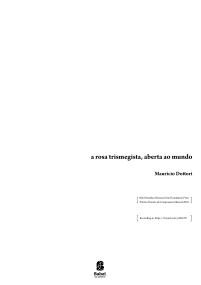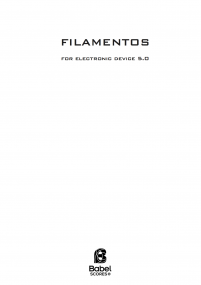Simulacrum
for orchesta
18,54 €
Digital version (+0,00 €) instant download
Printed format (+20,30 € printing and shipping). Colissimo7-14 days aprox.
When you buy a score, you can contact the composer right here!
Specifications
Region
Europe
Estimated Duration
16 - 20min
Date
2016
ISMN : 979-0-2325-3081-9
Notes on this piece
Add to a playlist
- Login to create your own lists
A simulacrum (from Latin: which means likeness, similarity) is a representation or imitation of a person or thing; copies that depict things that either had no original to begin with, or that no longer have an original. This piece largely deals with constant repetitions of ‘damaged’ materials and their potential expressiveness. The simulacrum is the content which affect or ‘modifies’ these repetitions; the system in which different relates to different by means of difference itself. ‘It is not the same which returns, it is not the similar which returns; rather, the same is the returning of that which returns, - in other words, of the Different.’ [G. Deleuze]
While it is a truism that music is an art of time, most of my pieces are concerned in some way with time and its perception which, in this piece, determines the formal principle of fragmentation in each case. Between each fragment is a simulacrum and the return of material affirms difference, dissemblance and disparateness, chance, multiplicity and becoming.
The original (virtual) material could be categorised as:
1. Texture (recognisable consistent quality field)
2. Gesture (semantically energized emotive signifier)
3. Figure (conglomerate of potentially independent formal markers)
and
border-states (time transformations): glissando, static texture, slowly changing texture, ‘coloured silence’, complete silence.
The piece ‘flirts’ with two types of time: the faster, highly figured material and; a ‘frozen’ sustained texture (border state). These border-states also create (in my perception) a “macro-rhythm” within the piece. But qualitatively perceived states can overlap, rather than being organized into a distinct succession as concepts; creating a (vision of) ‘confused multiplicity’. This is perhaps most apparent in the ‘insert’ of the percussion solo where figures occur against a timeless backdrop of ‘ethereal slow motion’.
A ‘concerto for ensemble’ Simulacrum is written for players often momentarily deployed in small chamber groups or, more rarely, as soloists. Although, because the wind section is populated with different register instruments (i.e. piccolo, flute / Bb clarinet, Bass clarinet / bassoon, contrabassoon) and the range of percussion is sizeable, my intention is that the piece’s colour-spectrum is richer still than the 23-strong ensemble suggests.
Please observe! the recording is version 1.00 which differs slightly from the published version 1.50
A ‘concerto for ensemble’ Simulacrum is written for players often momentarily deployed in small chamber groups or, more rarely, as soloists. Although, because the wind section is populated with different register instruments (i.e. piccolo, flute / Bb clarinet, Bass clarinet / bassoon, contrabassoon) and the range of percussion is sizeable, my intention is that the piece’s colour-spectrum is richer still than the 23-strong ensemble suggests.
Please observe! the recording is version 1.00 which differs slightly from the published version 1.50
Instrumentation
Flute (2)|Oboe (2)|Clarinet (2)|Bassoon (2)|Trumpet (2)|Horn (French Horn)|Trombone|Percussions (2)|Viola (2)|Cello (2)|Double bass|Violin (4)|Chamber Orchestra
Score Details
Format - A3 / Tabloid
Pages - 52
Pages - 52









